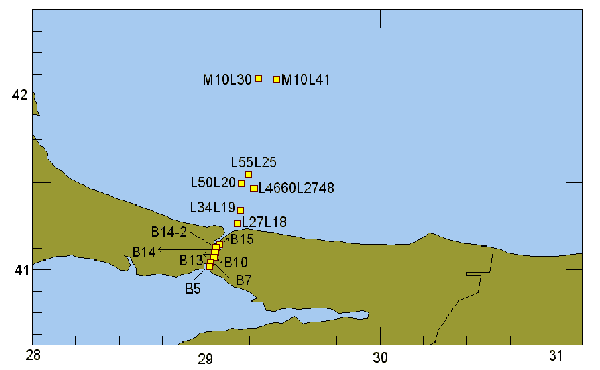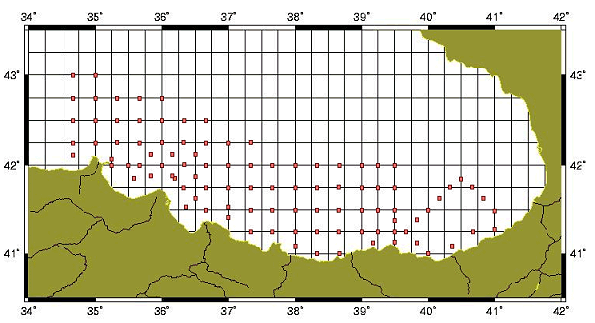
Cruise R/V BILIM
September-October 2000
R/V Bilim carried out a joint survey of two legs in the Black Sea to study the chemistry of the sub-oxic zone and the effectcs of the physical processes on the dynamics of the ecosystems during autumn. Specific objectives of the cruises were:
Scientists from Turkey, USA, Ukraine and Netherlands participated the cruises.
LEG I
The leg was dedicated to the measurements to study the physico-chemical reactions and biochemical properties of the sub-oxic zone. The leg started on September 22 and lasted on October 1, 2000. The parameters measured during the cruise were:
| Parameter | Matrix / Method |
| CTD | CTD Probe, vertical profile |
| Light transmission | Transmissometer, vertical profile |
| In situ fluorescense | Fluorometer, vertical profile |
| Secchi Disc depth | Secchi Disc |
| PO4, NO3, NO2, NH4, Si | Seawater, autoanalyzer |
| Dissolved Oxygen | Seawater, Winkler method |
| Hidrogen Sulfide | Seawater, colorimeter |
| Clorophyll& pheopigment-a | Particulate matter, Spectrofluorometer |
| POC | Particulate matter; CHN analyzer |
| PON | Particulate matter, CHN analyzer |
| POC | Particulate matter, colorimetric |
| Phytoplankton | |
| Zooplankton | |
| PAR | Quantameter |
| Reactive Fe and Mn , Fe (II) | Colorimeter |
| 15-N2 and Argon | Seawater |
| 15-NO3 and 15 | Seawater |
| Particulate DNA | Particulate matter, chemical analysis |
| Particulate Mn and Fe | Particulate matter, AAS |
The station location of Leg I

The cruise participants:
Prof. Ilkay Salihoglu (IMS-METU)
Prof. Suleyman Tugrul (IMS-METU), Chief Scientist
Dr. Semal Yemenicioglu (IMS-METU)
Selahattin Erdogan (IMS-METU)
Oguz Yigiterhan (IMS-METU)
Amy Callahan (Washington University, USA)
Barbara Paul (Washington University, USA)
Mehmet Demirel (IMS-METU)
Saim Cebe (IMS-METU)
Esabil Kakac (IMS-METU)
LEG II
In order to achieve its objectives the following measurements
were done during the cruise:
Physical measurements
The CTD data were obtained using SBE 11plus also equipped with
fluometer and transmissivity sensors. The CTD were carried
out from surface down to 550 m. Irradiance measurements (upward
and downward) were carried out by LI-1800UW model
spectroradiometer from surface down to 1% light level at 5
stations visited by noon time.
Chemical measurements
Dissolved nutrients, dissolved oxygen, H2S and chlorophyll-a
measurements were performed on every second CTD stations.
Sampling depths were chosen according to sigma-t levels.
Biological measurements
Phytoplankton (sampling by Niskin bottles) and zooplankton
(net sampling) measurements were carried out at every third CTD
stations. Taxonomic analysis will be carried out later.
Sub-mesoscale biomass of four different sized (100-200, 200-500,
500-1000, 1000-2000 mm sized) planktonic organisms were sampled.
The effects of food size and availability on the Calanus
euxinus egg production were determined. In addition to this
study, culturing of the Calanus euxinus in the laboratory
tried and egg, feccal pellet production and excretion of Calanus
will be determined in the laboratory.
Samples were collected to study the distribution of various
methylated sulfur compounds in seston, dissolved matter and
zooplankton.
Pigment samples were collected along the 3 transects in the Black
Sea from surface, sub-surface and below the sub-surface layer for
HPLC analysis.
Primary production measurements using 14C technique
(both using simulated in situ and artificial incubation)
were done at 2 stations in order to determine the photosynthetic
carbon production rates.
Station network for October 2000 cruise

CRUISE TEAM:
Dr. Sukru Besiktepe (IMS-METU), Chief scientist
Dr. Sengul Besiktepe (IMS-METU)
Dr. Dilek Ediger (IMS-METU)
Dr. Kem Tang (Netherlands)
Elif Eker (IMS-METU)
Adil Sezer (IMS-METU)
Murat Telli (IMS-METU)
Saim Cebe (IMS-METU)
Esabil Kakac (IMS-METU)
Sahin Bulut (IMS-METU)
Hasan Uslu (IMS-METU)
Tahir Tutsak (IMS-METU)
|